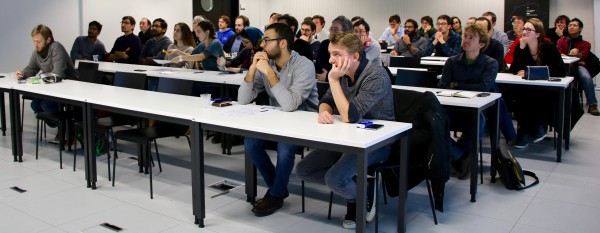MARVEL Junior Seminar — October 2018
The MARVEL Junior Seminars aim to intensify interactions between the MARVEL Junior scientists belonging to different research groups located at EPFL. The EPFL community interested in MARVEL research topics is very welcome to attend. We believe that these events will be central for establishing a vibrant community.
Each seminar consists of two presentations of 25 minutes each, allowing to present on a scientific question in depth, each presentation being followed by 10 minutes for discussion. The discussion is facilitated and timed by the chairperson of the day whose mission is to ensure active lively interactions between the audience and the speakers.
Pizza is served as of 11:45 in the MED hall (floor 0), and after the seminar at 13:30 you are cordially invited for coffee and dessert to continue discussion with the speakers.

MARVEL Junior Seminar Organizing Committee — Francesco Ambrosio, Davide Campi, Edgar Engel, Gloria Capano, Michele Pizzochero, Kun-Han Lin, Francesco Maresca and Patrick Mayor
Check the list of the next MARVEL Junior Seminars here.
Abstract — Revealing the interplay between covalent and non-covalent interactions in organic molecular crystals under pressure with DORI - Benjamin Meyer
Benjamin Meyer,1,4 Laurent Vannay,1 Benoît Guillot,2 Senja Barthel,3,4 Berend Smit,3,4 and Clémence Corminboeuf1,4
1Laboratory for Computational Molecular Design, École Polytechnique Fédérale de Lausanne (EPFL), Lausanne, Switzerland
2Université de Lorraine, Laboratoire CRM2, UMR 7036, Vandoeuvre-lès-Nancy, France
3Institut des Sciences et Ingénierie Chimiques, Valais, Ecole Polytechnique Fédérale de Lausanne (EPFL), Sion, Switzerland
4National Center for Computational Design and Discovery of Novel Materials (MARVEL), École Polytechnique Fédérale de Lausanne (EPFL), Lausanne, Switzerland
Organic molecular crystals subject to high pressures provide fundamental insights on crystal packing distortions, as well as on the mechanisms of phase transitions and polymorphs crystallizations. It is now possible to follow such solid state transformations analyzing experimental charge densities determined at high pressure. However, the analysis of the electron density alone struggles to properly describe chemical bonding and intermolecular interactions. A solution to overcome this problem takes advantage of molecular scalar fields, which are standard bonding descriptors able to extract chemical information from wave functions or electron densities.1 The orbital dependence of the wave function-based scalar fields unfortunately, hampers their application to experimental densities, orbital-free approaches or machine learned electron densities.2 The Density Overlap Region Indicator (DORI)3 conveniently capture simultaneously covalent patterns and non-covalent interactions, using only the electron density and its derivatives. We here exploit DORI on experimental electron densities to rationalize the bonding modifications in the illustrative biscarbonyl[14]annulene occurring at high pressure.4 In this context, we also develop an approach for analyzing the evolution of the DORI isosurface using a flood fill type algorithm, which avoid the abritraily comparison of the electronic structure at ambient and high pressure. This work demonstrates the usefulness of scalar field to extracts chemical information from organic solids. Future applications include real-time visualization of chemical fingerprints2 and mapping of the relative stability of molecular crystal polymorphs.
[1] E. Pastorczak, C. Corminboeuf, J. Chem. Phys. 2017, 146, 120901.
[2] A. Grisafi, A. Fabrizio, B. Meyer, D. Wilkins, C. Corminboeuf and M. Ceriotti, ACS. Centr Sci., submitted.
[3] P. de Silva, C. Corminboeuf, J. Chem. Theory Comput. 2014, 10, 3745.
[4] B. Meyer, L. Vannay, B. Guillot, S. Barthel, B. Smit and C. Corminboeuf, in preparation.
Abstract — First-principles-based prediction of yield strength in the RhIrNiPdPtCu high entropy alloy - Binglun Yin
High entropy alloys (HEAs) are random solid solution alloys with 5 or more components, usually of near equi-composition. HEAs exhibit excellent mechanical properties, including high strength, high ductility, and high fracture toughness [1]. Guiding the design of new HEAs across the vast composition space requires an ability to compute necessary underlying material parameters via first-principle calculations. Here, a methodology is proposed to compute, via density functional theory (DFT), the elemental misfit volumes, as well as alloy lattice constant, elastic constants and stable stacking fault energy, in the fcc noble metal HEA RhIrNiPdPtCu [2]. These properties are then used in a recently developed solute strengthening model [3, 4] for temperature and strain-rate dependent yield strength, with the prediction of 583 MPa is in excellent agreement with the experimentally measured value of 527 MPa [5]. This methodology connects the alloy composition with the yield strength prediction, indicating a general methodological path for exploring new potential high-strength HEAs in this and other alloy classes.
[1] D. B. Miracle and O. N. Senkov, Acta Mater. 122, 448 (2017).
[2] B. Yin and W. A. Curtin, in preparation.
[3] C. Varvenne, A. Luque, and W. A. Curtin, Acta Mater. 118, 164 (2016).
[4] C. Varvenne, G. P. M. Leyson, M. Ghazisaeidi, and W. A. Curtin, Acta Mater. 124, 660 (2017).
[5] S. Sohn, Y. Liu, J. Liu, P. Gong, S. Prades-Rodel, A. Blatter, B. E. Scanley, C. C. Broadbridge, and J. Schroers, Scr. Mater. 126, 29 (2017).
Low-volume newsletters, targeted to the scientific and industrial communities.
Subscribe to our newsletter